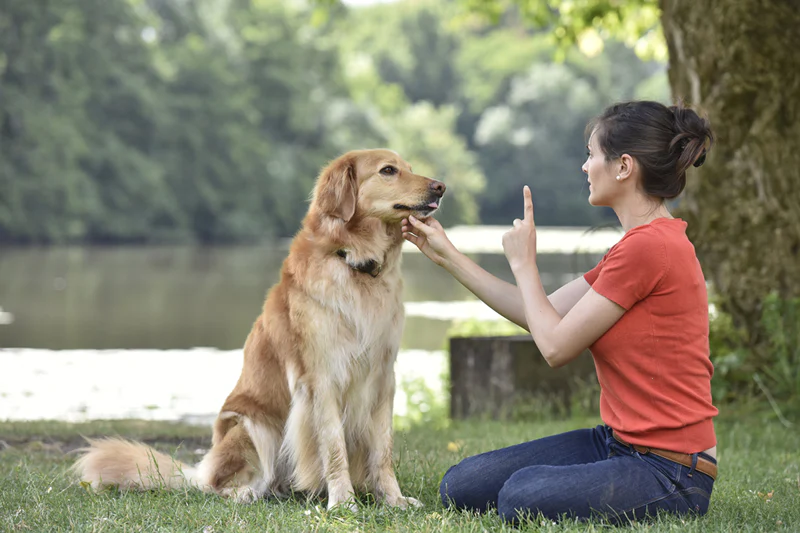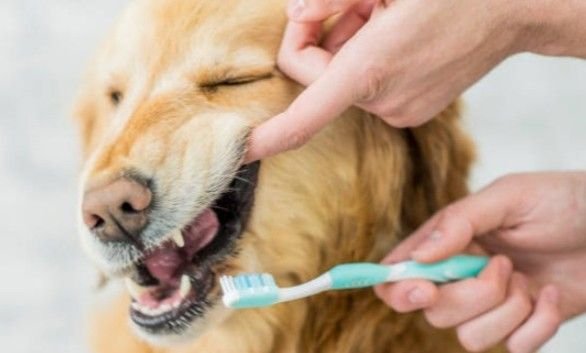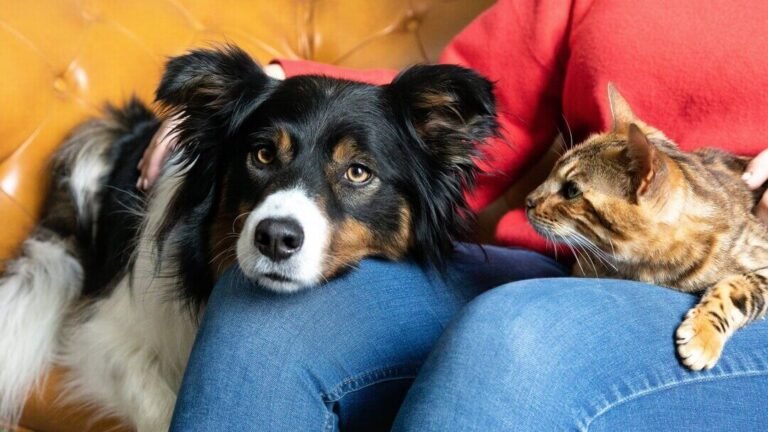Train Your Dog At Home Without Any Expert’s Help
Whether you’re teaching your dog to sit, stay, or stop barking, you should always begin with a fundamental idea. For example, understanding them is ESSENTIAL if you want to reap immediate advantages and improve your bond with your canine partner.
Do you wish to learn dog training techniques? We provide you three very important reminders!
Your dog needs to entirely adjust its mind first.
You’ll spend the entire time fighting a losing battle if you don’t take this first.
When I say that you must “earn your dog’s head,” I mean that your dog must depend on you for all choices. I advise viewing this video series on how to become the pack straight away to get started.
You are simply setting yourself up for misery and failure if you aren’t putting the principles from these videos into practise. If you don’t, your dog will still flee and act independently the next time you need them to behave.
Or if you have a dog who obeys your directions and guidance almost always, perhaps even 99% of the time… But now, isn’t it not quite 100%? Let me put it this way: if you want a dog who ALWAYS listens, you have to change their mind!
The following key—some might even say the second—is…
Your dog needs encouragement. You must know for sure what your dog enjoys doing for play or exercise, as well as what they desire as a reward. By making training fun for both you and your dog, you’ll both learn more and eagerly anticipate the next training session.
Scooter, my dog, likes to play fetch. Your dog might enjoy swimming, running a course of obstacles, playing tug-of-war, or (if you’re lucky) learning how to be obedient. When you first start out, be sure you have a solid understanding of what they enjoy doing and how to encourage them.
The three primary categories of awards are as follows:
- Food: kind of startling, huh? A piece of meat or a little dog biscuit could be used.
- Give affection by giving pats, embraces, belly massages, cuddles, or even just enthusiastic verbal adulation.
- Playing with toys, such as fetch, chase, and pull.
- If you train your dog in a fair and generous manner, they will always be more eager to cooperate with you. If you want not to use food, that is acceptable. Just be sure to show your dog the right level of affection when they behave well.
If you do decide to utilise food as a reward, make sure to always go by these simple rules:
- Always be certain to mix up the food reward.
- Don’t always reward them with food
- Keep your dog in the dark about the prize.
- If your dog doesn’t comply the first time, don’t reward them.
Practice is the third and last key.
It takes time to become an expert at something. You must discover what motivates your dog to behave in the way you desire, then keep doing it.
Any incentive you have selected for your dog will now be put into action. Negative training is unnecessary if you correctly entice your dog and demonstrate the behaviour you want from them.
How to Become the Pack Leader of Your Dog
How to communicate to your dog that you are in command, the “Top of the class,” “the head honcho,” or, of course, “the leader of the pack” is a question I hear frequently when it comes to training dogs.
The pack leader is a crucial role to hold since other canines look to him for leadership. When we go for a stroll, they instruct us on what to sniff, which bushes and trees to pee on, and other things.
You’ll see why it’s crucial that you be the one in charge after you realise and appreciate how much hierarchy matters in dog packs. Giving your dog control is a formula for disaster that can only result in negative outcomes and difficult circumstances for both you and your dog. Stop that from happening!
Here’s how to make your dog the alpha dog in the pack.
But before we discuss how you will take charge of your dog pack, it’s crucial that you get that your four-legged companion doesn’t really care what happens in the end.
Your dog will completely disregard the kinds of things we concentrate over, such as the make and model of our cars, who we are dating, or how much money someone makes, as soon as their favourite treat or toy appears.
However, the best method to establish yourself as their pack leader is not by being overly domineering with your dog. You’ll get into difficulty down the future if you give your dog the notion that everything comes down to physical prowess.
Your dog may indeed submit to you, but not because you have proven to be a deserving leader; rather, it will be because you have demonstrated that you are the local “bully,” or more simply, more physically powerful.
How do I take over as the pack leader of my dog, then? All dogs use the same methods to decide who will be the pack leader, regardless of breed or even where they are born.
I’ve discovered throughout the years that viewing videos of experienced trainers is the best method to learn new things. It’s how I learnt, and it’s what I advise other people who want to train their dog to do.
Keeping the following in mind as you learn to assert your authority:
- When their dog barks or becomes aware, the pack leader maintains their composure and control.
- Your dog shouldn’t drag you when out for a walk, not even at the start when they’re excited. One of the first videos I would watch is on how to teach your dog to walk correctly.
- Your dog will be able to unwind and “turn off” completely when inside your house when you are the group leader. When your dog becomes overly excited inside, it’s obvious they believe they are in charge of the pack.
- How you greet your dog when you get home has a direct bearing on how you teach them to switch off when you’re home. It’s important to watch videos of skilled specialists in this situation because they can show you the TINY distinctions between a dog owner who is a follower and a pack leader’s conduct.
- Last but not least, feeding your dog properly will demonstrate to them your authority. And training kids to sit is just one part of it!
- I wish you well and a prosperous future with your dog!
Can I train my dog without a trainer?
Yes, you can certainly train your dog without a professional trainer. Many dog owners successfully train their dogs on their own through consistent effort, patience, and positive reinforcement techniques. Here are some steps you can take to effectively train your dog without a trainer:
- Research and Education: Before you begin training, educate yourself about dog behavior, training methods, and positive reinforcement techniques. There are plenty of books, online resources, and videos available that can help you understand the basics of dog training.
- Start with Basic Commands: Begin with basic commands like sit, stay, come, and down. These commands lay the foundation for more advanced training. Use treats, praise, and rewards to reinforce desired behaviors.
- Consistency: Consistency is key in dog training. Use the same cues and commands each time, and make sure everyone in your household is on the same page with the training approach.
- Positive Reinforcement: Reward your dog with treats, praise, and affection when they perform the desired behavior. Positive reinforcement encourages your dog to repeat the behavior.
- Short Sessions: Keep training sessions short and focused, especially at the beginning. Dogs have shorter attention spans, so frequent short sessions are more effective than long, exhausting ones.
- Patience: Dogs learn at their own pace. Be patient and avoid getting frustrated if progress seems slow. Training takes time, and every dog is different.
- Avoid Punishment: Avoid using punishment-based methods, as they can damage the trust between you and your dog and may lead to fear-based behaviors.
- Socialization: Expose your dog to different people, animals, and environments to help them become well-adjusted and confident.
- Leash Training: If your dog needs leash training, practice walking on a leash in a controlled environment. Use positive reinforcement to reward good leash behavior.
- Problem Solving: Address any behavioral issues one at a time. Seek advice from reputable sources or consider consulting a veterinarian if you encounter particularly challenging behaviors.
- Advanced Training: As your dog progresses, you can move on to more advanced training, such as tricks, agility, or even specialized tasks like service dog training.
- Practice Everywhere: Practice the commands in various settings to ensure your dog understands and follows commands regardless of distractions.
Remember that every dog is unique, so some methods might work better for your dog than others. If you find yourself struggling with certain aspects of training or encountering specific challenges, don’t hesitate to seek advice from experienced dog owners, attend local training classes, or consult with a professional trainer if needed.
How do I train my dog to be good home alone?
Training your dog to be comfortable and well-behaved when home alone involves gradual desensitization, positive reinforcement, and creating a safe and comfortable environment. Here are steps you can take to train your dog to be good home alone:
1. Start with Short Periods:
- Begin by leaving your dog alone for short periods of time, gradually increasing the duration as they become more comfortable. This helps prevent separation anxiety.
2. Create a Safe Space:
- Designate a specific area in your home where your dog feels safe and comfortable. This could be a room with their bed, toys, and water bowl.
3. Leave Interactive Toys:
- Provide your dog with interactive toys, puzzle feeders, or Kong toys filled with treats. This keeps them mentally stimulated and entertained in your absence.
4. Establish a Routine:
- Establish a consistent daily routine for your dog, including feeding, bathroom breaks, and playtime. Predictable routines can help reduce anxiety.
5. Desensitize Departures:
- Practice casual departures by putting on your shoes or grabbing your keys without actually leaving. This helps desensitize your dog to the cues associated with your departure.
6. Ignore Excitement:
- When leaving and returning, ignore your dog’s excited behavior for a few minutes. This helps prevent reinforcing overly emotional reactions.
7. Practice Alone Time:
- Encourage short periods of alone time even when you are home. Use a cue like “stay” and gradually increase the distance between you and your dog.
8. Use Comfort Items:
- Provide comfort items such as a blanket or clothing with your scent. This can help reassure your dog in your absence.
9. Train in Increments:
- Break down training into small increments. For example, leave your dog alone for a few minutes, then return and reward them. Gradually increase the time as they become more accustomed.
10. Positive Departures and Returns:
- Make departures and returns low-key and positive. Avoid emotional farewells or arrivals to prevent heightening your dog’s anxiety.
11. Consider a Pet Sitter or Dog Walker:
- If possible, hire a pet sitter or enlist the help of a friend or neighbor to break up long periods of solitude.
12. Use Calming Pheromones:
- Consider using calming pheromone diffusers or sprays to create a soothing environment.
13. Seek Professional Help:
- If your dog exhibits signs of severe anxiety or distress when left alone, consider consulting with a professional dog trainer or behaviorist for personalized guidance.
14. Monitor Behavior:
- Use a camera or monitor to observe your dog’s behavior when you’re away. This can help you assess their comfort level and make adjustments as needed.
15. Consult with a Veterinarian:
- If your dog continues to struggle with being alone, consult with your veterinarian. They can rule out any underlying health issues and may provide additional guidance.
Consistency, patience, and positive reinforcement are key components of training your dog to be good home alone. Gradual desensitization, combined with creating a comfortable environment and providing mental stimulation, can help your dog feel more secure in your absence.
What are the 7 most important dog commands?
The importance of dog commands may vary depending on individual needs and preferences, but here are seven basic commands that are generally considered essential for effective communication and training with dogs:
- Sit:
Teaching your dog to sit is a fundamental command. It helps in controlling your dog and is often used in various situations, such as before crossing the street or greeting people. - Stay:
The “stay” command is crucial for keeping your dog in one place until you give them the signal to move. This can be essential for safety in various situations, like when a car is approaching or when you need your dog to remain in a specific location. - Come:
Teaching your dog to come when called is essential for their safety and your peace of mind. It’s particularly important in off-leash situations or when you need your dog to return to you quickly. - Down (or Lie Down):
This command is useful in situations where you want your dog to lie down and stay calm, such as when you’re having a meal or when guests arrive. - Leave It:
This command is valuable for preventing your dog from picking up or interacting with something they shouldn’t, whether it’s food, an object, or another animal. - Off:
Teaching your dog to get off furniture or not to jump on people can be essential for maintaining a well-behaved and polite pet. - Heel:
Heel is a command used to teach your dog to walk calmly and closely by your side. This is particularly helpful during walks and when navigating crowded or public spaces.
Consistency and positive reinforcement are key when training your dog. Tailor these commands to suit your specific needs and lifestyle, and remember that patience and positive reinforcement go a long way in dog training.
What is the hardest dog command?
Determining the “hardest” dog command can be subjective and depends on various factors, including the individual dog’s temperament, breed, and the owner’s training approach. However, one command that many find challenging to teach and for dogs to master is:
Recall (Come):
Teaching a reliable recall command, where a dog returns to its owner promptly when called, can be challenging. It requires consistent training, especially in distracting environments. Dogs may be easily distracted by other animals, scents, or interesting stimuli, making it difficult for them to focus on the recall command.
The recall command is crucial for the safety of the dog, especially in situations where immediate obedience is necessary. Achieving a strong recall involves building a solid foundation of trust and positive reinforcement during training sessions. It’s essential to make coming to the owner a rewarding and positive experience for the dog. Consistent practice in various environments helps reinforce the command’s reliability.
Which dog learns the fastest?
The speed at which a dog learns depends on various factors, including the individual dog’s breed, temperament, and motivation, as well as the training methods used by the owner. However, some dog breeds are generally known for their intelligence and quick learning abilities.
Border Collie: Often considered one of the most intelligent dog breeds, Border Collies are known for their problem-solving skills and eagerness to learn. They excel in obedience training and various canine sports.
Poodle: Poodles are highly trainable and known for their intelligence. They come in three sizes: standard, miniature, and toy. Poodles are often used in obedience training and dog shows.
German Shepherd: German Shepherds are known for their versatility and are commonly used as police, service, and working dogs. They are quick learners and can excel in various training activities.
Golden Retriever: Golden Retrievers are not only known for their friendly nature but also for their intelligence. They are often used as guide dogs, therapy dogs, and in various canine sports.
Doberman Pinscher: Dobermans are known for their intelligence, loyalty, and trainability. They can quickly pick up commands and are often used as working dogs in various roles.
It’s important to note that individual dogs within any breed can vary in their learning speed. Additionally, factors such as early socialization, positive reinforcement, and consistency in training play a significant role in a dog’s ability to learn quickly. Regardless of breed, each dog is unique, and training success depends on the owner’s commitment and approach to training.









